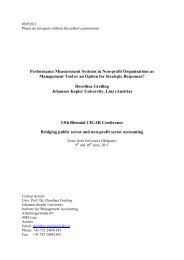Predicting Partial Customer Churn Using Markov for Discrimination ...
Predicting Partial Customer Churn Using Markov for Discrimination ...
Predicting Partial Customer Churn Using Markov for Discrimination ...
Create successful ePaper yourself
Turn your PDF publications into a flip-book with our unique Google optimized e-Paper software.
P (x|non-churners)<br />
S(x) = log<br />
P (x|churners)<br />
This ratio S(x) allows the affinity of a customer to be measured with respect to non-churners<br />
and churners, by means of their specific product category purchase sequence. A positive ratio<br />
indicates that the customer is not likely to churn while a negative ratio means the opposite.<br />
For example, consider the purchase sequence of three products. Since we are interested in<br />
discriminating between churners and non-churners, we construct a transaction matrix <strong>for</strong> each<br />
population. Each matrix contains, <strong>for</strong> each population the probability of a customer buying <strong>for</strong><br />
the first time from product category Pi, in period t, and then buying <strong>for</strong> the first time product<br />
category Pj, in period t + 1. Consider the following transition matrices:<br />
The log-odds ratio of a customer whose first purchase sequence is P3 −→ P1 −→ P2 can be<br />
calculated as follows:<br />
S(P3 −→ P1 −→ P2) = log 0.4 0.2<br />
+ log<br />
0.7 0.6<br />
= −0.7 (5)<br />
The odds that the sequence stems from the non-churners’ population is 0.7 times smaller than<br />
the odds that he sequence stems from the churners’ population (see Equation (3)). There<strong>for</strong>e,<br />
this hypothetical customer is likely to churn.<br />
In this study, we trans<strong>for</strong>m S(x) in two variables, i.e. non-churner likelihood and churner likelihood.<br />
As a result, positive log-odds ratios are assigned to the non-churner likelihood variable,<br />
while negative log-odds ratios are assigned to the churner likelihood variable.<br />
3.3 Techniques<br />
3.3.1 Logistic regression<br />
Logistic regression is a well-known technique which can be used <strong>for</strong> classification purposes. This<br />
is a <strong>for</strong>m of regression which is generally used when the dependent variable is a dichotomy. The<br />
independent variables can be of any type (Agresti, 1996). The relationship between the dependent<br />
variable and the independent variables is not assumed to be linear in a logistic regression.<br />
In fact, this technique assumes that the independent variable is linearly related to the logit of<br />
the dependent variables. The logistic regression technique does not require normally distributed<br />
7<br />
(3)<br />
(4)
















